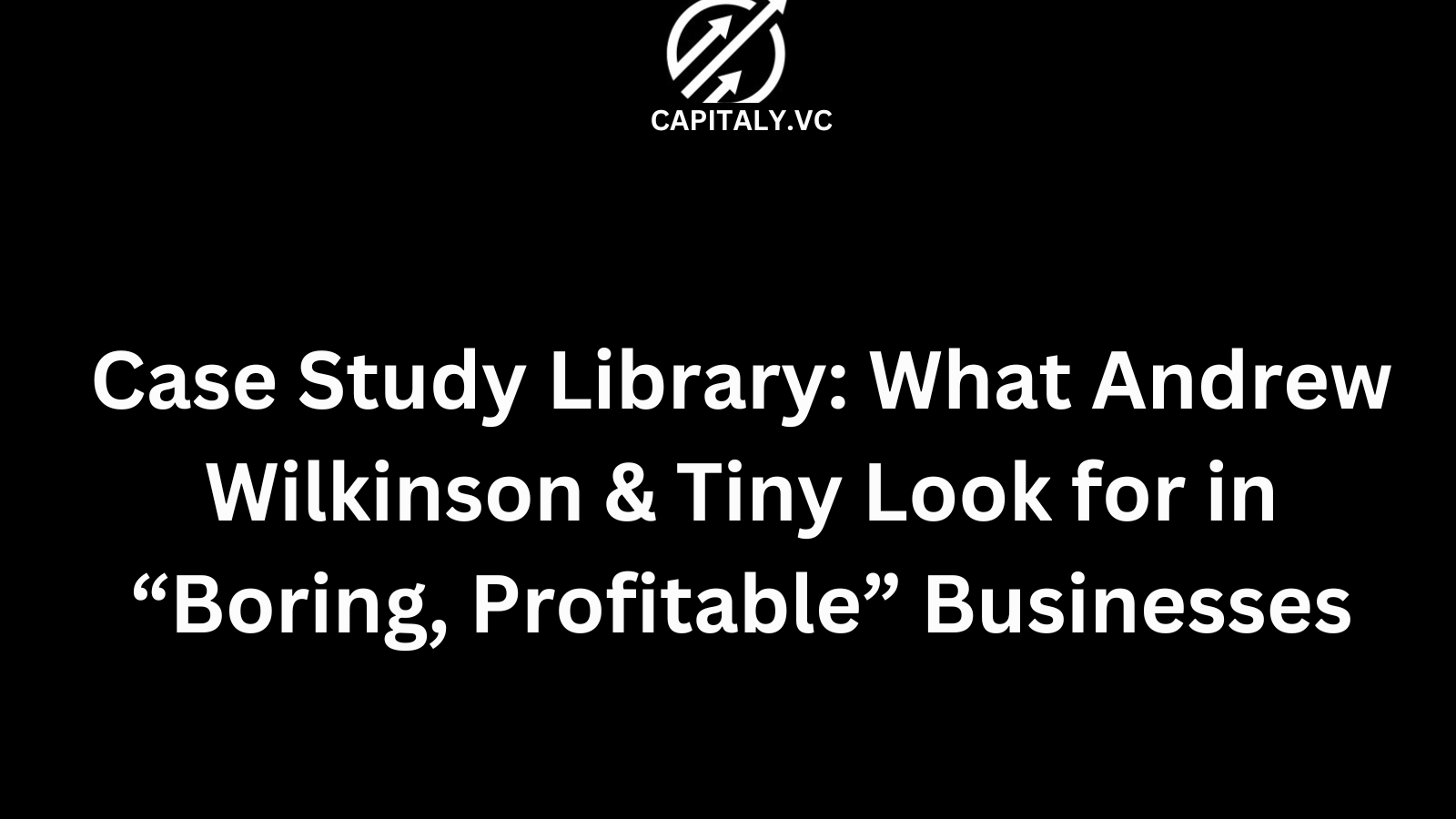Case Study Library: What Andrew Wilkinson & Tiny Look for in “Boring, Profitable” Businesses
Case Study Library: What Andrew Wilkinson & Tiny Look for in “Boring, Profitable” Businesses

Case Study Library: What Andrew Wilkinson & Tiny Look for in “Boring, Profitable” Businesses is my no-nonsense guide to the patterns I say “yes” to fast.
You’ll see the signals I underwrite, the traps I flag, and four mini case studies that show exactly why a deal closes in ~30 days.
I’ll keep it plain English, first person, and every sentence on a new line.
I’ll add copy-paste checklists and internal links so you can go deeper where it helps.

H2 — What “boring, profitable” means to me
“Boring” means predictable, durable, and low-drama.
It means customers renew because the product works, not because we run promotions.
It means managers and SOPs run the machine without founder heroics.
“Profitable” means EBITDA converts to free cash flow at a healthy rate.
I buy cash engines, not stories.
H2 — The common patterns across our best case studies
The best deals share ten traits.
Cash-backed earnings.
Pricing power.
Repeatable revenue.
Low concentration.
Tight working-capital discipline.
Boring legal.
Simple tech with backups.
Documented SOPs.
Replaceable founders.
Clean, fast communication.
For cadence and ruthless brevity, see our blog post: I Don’t Respond to Long Emails.
H2 — Signal #1: Cash-backed earnings (EBITDA → FCF)
I start at EBITDA and land on unlevered free cash flow after maintenance capex and working capital.
If EBITDA → FCF is consistently strong, I stretch on cash at close.
I want a simple cash→accrual bridge and bank tie-outs.
For a QoE-lite checklist, see: Quality of Earnings for SMBs.
H2 — Signal #2: Pricing power without churn
I price pricing power.
Show the last two price increases and the impact on churn and net revenue retention.
If NRR stayed ≥100%, your moat is showing.
If discounting crept up, show what changed.
Clarity beats cleverness.
H2 — Signal #3: Recurring revenue and repeat purchase
I pay for recurring revenue and repeat purchase proven by cohorts.
Plot 12–36 month curves and annotate dips with fixes.
Subscriptions with low churn and annual contracts with renewals are gold.
One-and-done models are fragile.
H2 — Signal #4: Customer concentration within bounds
I like top customer <25% of revenue.
If you’re over, show contract terms, renewal history, and a dilution plan.
I can price concentration, but I won’t guess.
H2 — Signal #5: Working-capital discipline and the peg
A fair peg is the quiet paragraph that moves six or seven figures.
I set pegs from 12 monthly snapshots, adjust for seasonality, and true-up dollar-for-dollar.
Define inclusions and exclusions in one sentence.
For the one-page version, read: Working Capital Peg Explained.
H2 — Signal #6: Operational cadence and SOPs
I want weekly KPIs, owners per metric, and written SOPs for the cash cycle.
Predictability is the asset I buy.
If everything routes through the founder, we’ll plan a short, paid transition with clear deliverables.
H2 — Signal #7: Platform risk contained
If a single platform flips a switch and your revenue drops, I slow down.
I want mitigations: owned channels, diversified acquisition, and clear playbooks.
Name the risk and show the fix in two bullets.
For a mindset reset on focus, see: Delete 95% of Your Email.
H2 — Signal #8: Simple tech and security hygiene
I want SSO, access hygiene, backups, RTO/RPO, and an incident log.
One engineer as a single point of failure is a plan, not a deal-breaker.
We’ll design a short transition to spread keys and document the stack.
H2 — Signal #9: Legal and IP cleanliness
I want clean IP assignments, a current cap table, and contracts with change-of-control terms listed early.
Boring legal is fast legal.
If there’s legacy weirdness, fix it pre-LOI.
For story over jargon, see: Never Tell, Always Storytell.
H2 — Signal #10: Team replaceability and bench
I love managers who own outcomes and a bench that can absorb vacations without fire drills.
If you’re still key to sales, we’ll price that and plan a handover.
Replaceability raises certainty and speeds closing.
H2 — The data room pack we say “yes” to
Upload the Vital 20% first.
Financials: TTM P&L tied to bank, last 3 years, cash→accrual bridge, labeled add-backs.
Customers: Top-20 by month (36 months), cohorts, GRR/NRR.
WC: AR/AP aging, inventory or deferred revenue schedules.
Legal: Contracts, IP assignments, cap table.
Ops: Org chart, top 10 SOPs.
Keep Q&A in one thread.
H2 — LOI terms that make these deals close fast
Economics stay non-binding.
Exclusivity, confidentiality, expenses, governing law, announcements, and the peg are binding.
I cap indemnities, set a modest escrow, and push more cash at close.
If you want a plain-English LOI, use our template in the post: Never Tell, Always Storytell.
H2 — Red flags we walk from
“Trust-me” add-backs.
Hidden liabilities.
Off-platform payments that dodge the take rate.
Promo-propped demand that dies when coupons stop.
If it’s fixable, show the fix now and I’ll price it fairly.
H2 — Case Study A: B2B SaaS with workflow depth
The gist.
$12M ARR.
$3.8M EBITDA.
NRR 106%.
Core module embedded in daily workflows.
Signals.
Price increase of 8% with churn flat.
12-month payback on core channel.
Deferred revenue handled cleanly with a tight recognition policy.
Outcome.
Clean peg.
Short diligence.
High cash at close.
For compounding taste, read: A $3,600 Keyboard and a $66 Million Dollar Investment.
H2 — Case Study B: E-commerce brand with inventory truth
The gist.
$2.4M EBITDA.
Gross margin 58%.
Turns 5.2× in A SKUs.
Signals.
Inventory valued at lower of cost or NRV.
Obsolescence reserve in place.
Returns down 220 bps after a product tweak.
Outcome.
Seasonally adjusted peg.
Dollar-for-dollar true-up.
Fast close with modest escrow.
H2 — Case Study C: Services marketplace with real liquidity
The gist.
GMV $85M.
Take rate 12%.
CM/Tx positive pre fixed costs.
Signals.
Median time-to-match <24h in hot pockets.
Leakage <8% thanks to on-platform payments + warranty.
Chargebacks trending down for six straight quarters.
Outcome.
Short, small earnout tied to gross profit only.
Locked governance and audit rights.
Heavy cash at close.
H2 — Case Study D: Productized agency with SOPs
The gist.
$1.6M EBITDA.
90% of work delivered via standard packages.
Signals.
Bench capacity tracked weekly.
NPS 68 with documented handoffs.
Founder at 10 hours/week.
Outcome.
Simple SPA.
Capped indemnities.
30-day close from LOI.
H2 — Build-your-own case study: the template I use
Snapshot.
What you are, who you serve, TTM revenue and EBITDA, growth, margin.
Moat.
The thing a smart competitor can’t replicate in 12 months.
Evidence.
Cohorts, price tests, concentration, peg math.
Fixes.
Two bullets on known risks and what you already did.
Deal ask.
Your preferred structure, cash at close, and 30-day close plan.
H2 — The 30-day timeline I actually run
Days 1–3.
Four-line email.
8-slide deck.
Vital 20% data room.
Days 4–10.
Terms aligned.
LOI signed.
Focused diligence calendarized.
Days 11–20.
Financial, legal, tech sprints.
Customer calls.
Draft SPA.
Days 21–30.
Final markups.
Funds flow.
Day-1 comms and KPI cadence.
For rhythm, see: 02: Journaling With AI.
H2 — Communication hygiene that halves your timeline
One owner per domain.
One checklist.
One weekly summary.
Short, numbered emails.
Decisions captured inline.
For tone and speed, read: I Don’t Respond to Long Emails.
H2 — Where founders quietly lose money at close
Vague peg definitions.
Sloppy earnout metrics.
Unlimited indemnities.
Confused working-capital schedules.
Fix these in the LOI and you convert complexity into cash at close.
Copy-Paste: The “Vital 20%” Case Study Checklist
Financials
TTM P&L tied to bank.
3-year history.
Cash→accrual bridge.
Labeled add-backs.
Customers
Top-20 by month (36 months).
GRR/NRR with notes on dips and fixes.
Price tests and outcomes.
Working Capital
AR/AP aging.
Inventory or deferred revenue schedules.
12-month peg snapshots.
Legal & IP
Key contracts.
Change-of-control and consent list.
Employee and contractor IP assignments.
Ops & Tech
Org chart and top 10 SOPs.
Access hygiene, backups, RTO/RPO.
Single-point-of-failure plan.
FAQs
What’s the fastest way to make my business look “boring, profitable.”
Tie revenue to bank, publish a cash→accrual bridge, and show cohorts with price power.
Do I need audited financials to get a real offer.
No.
I need reconciled statements and clean schedules that pass the sniff test.
How much concentration is too much.
Over 25% in one customer slows things down.
Show contracts and a plan to dilute.
What if I rely on one platform for demand.
Name the risk, show mitigations, and include owned-channel progress.
Will you accept an earnout.
Yes when short, small, and tied to gross profit with locked governance.
Otherwise I prefer more cash and a modest escrow.
How do I present inventory without optimism.
Use lower of cost or NRV, add an obsolescence reserve, and show turns by SKU.
What’s the single slide that moves my multiple.
Pricing power with stable churn and NRR ≥100%.
How do you compare two offers with different structures.
Convert both to cash at close after peg and escrow, then discount contingencies for risk and time.
What kills deals late.
Hidden liabilities, “trust-me” add-backs, and vague peg math.
Can we really close in ~30 days.
Yes with a tight room, crisp answers, and standard docs.
Speed is a choice.
How should I prep my team without spooking them.
Share a one-page Day-1 memo on continuity, roles, and the next 90 days.
Where can I learn the communication style you want.
Start with these posts: Never Tell, Always Storytell and I Don’t Respond to Long Emails.
Conclusion
Case Study Library: What Andrew Wilkinson & Tiny Look for in “Boring, Profitable” Businesses comes down to cash-backed earnings, clean pegs, pricing power, and predictable operations you can prove in a few pages.
Bring cohorts, tie-outs, and SOPs, fix the quiet traps in the LOI, and we can usually get to an LOI in 7–10 days and close in ~30 with more cash at close and less drama.
Get Your Copy of Never Enough at https://www.neverenough.com/



.png)